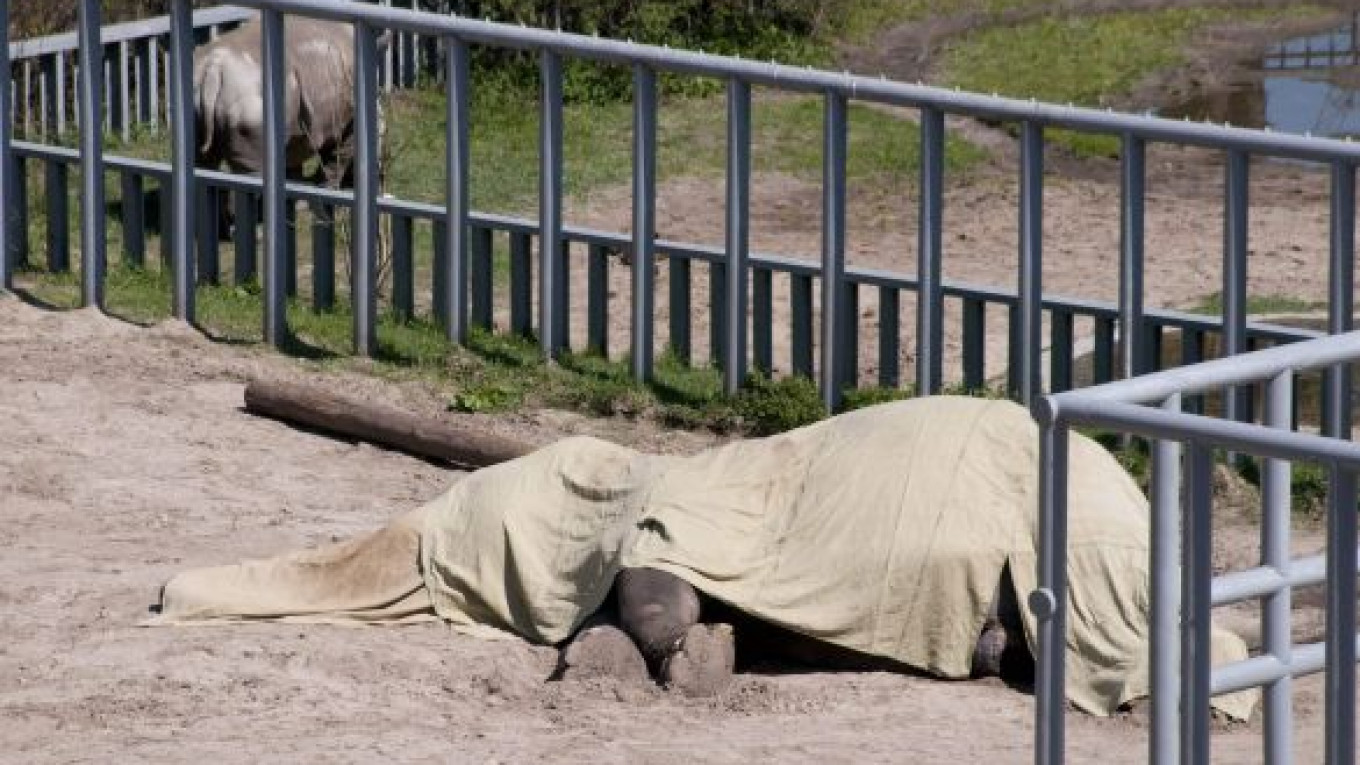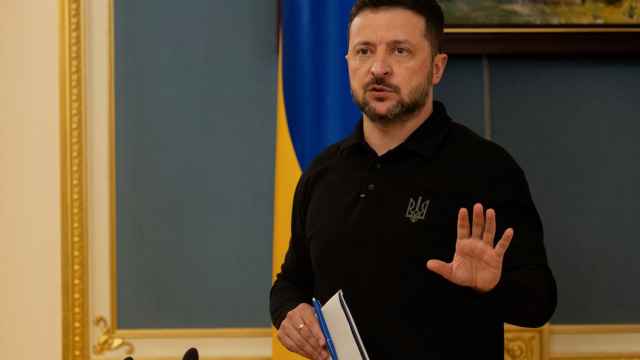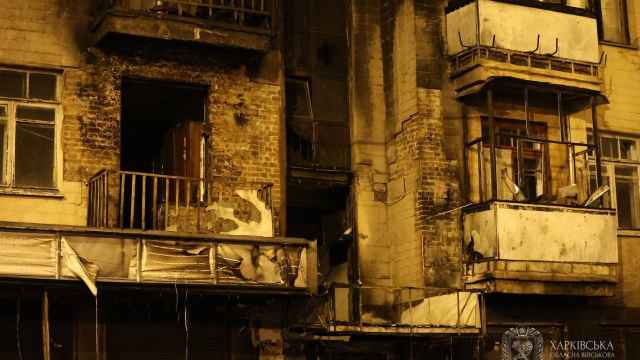KIEV – An Indian elephant called Boy, the pride of the Kiev Zoo, collapsed and died in his enclosure. Around the same time, Maya the camel succumbed to a digestive illness, and Theo the zebra died after crashing into a metal fence.
And there's more, much more.
The animals just keep on dying at the Kiev Zoo, a place some have likened to an unkempt warehouse for those with fur and feathers. Animal welfare groups say dozens if not hundreds of animals have died at the zoo in recent years due to malnutrition, a lack of medical care and mistreatment — and some suspect that corruption is at the heart of the problem.
Naturewatch, a British-based animal welfare group, is among the organizations calling for the 100-year-old zoo to be closed and its animals sent elsewhere in Europe.
"The Kiev Zoo will never attain any basic standards, it's so far removed from any zoo in Europe," said John Ruane of Naturewatch. "The conditions have been absolutely horrendous, and no matter how many more directors were appointed the situation still remained the same."
New managers appointed in October said nearly half of the zoo's animals either died or mysteriously disappeared over two years under their predecessors, and a government audit found that thousands of dollars were misspent as animals were illegally sold and funds earmarked for their food and care disappeared. Ukrainian prosecutors have also opened an investigation.
But despite the management change, the zoo's animals are still dying. Some activists suspect a secret real estate deal is in the works — that the zoo is being deliberately decimated so it can be closed down and the prime land that it sits on in the center of Kiev can be sold.
Other violations included the purchase of medication for already deceased apes, paying for hyenas that were never shipped to the zoo, the illegal sale of 12 macaques, the unrecorded sale of zoo tickets and the misallocation of funds earmarked for feeding zoo animals. The violations totaled 1.6 million hryvnas ($200,000), according to Irina Parkhomenko, spokeswoman for the government auditing agency.
Once the jewel of the Ukrainian capital and a favorite weekend spot for families, the zoo began to deteriorate after the Soviet collapse and the years of poverty that followed. Animals were kept in cramped, poorly lit and poorly heated enclosures, fed improperly and left unattended, according to watchdogs.
The Kiev Zoo gained international notoriety in 2007 when it was expelled from the European Association of Zoos and Aquaria after the tragic death of a female bear.
The elderly brown bear named Dinara had been moved from a small enclosure where she had spent all her life to a bigger pen with a male Malayan sun bear. Stressed by the new premises and her new companion, Dinara began to bang her head against the concrete walls of the enclosure, leaving blood stains on the walls and floor. After days of this, she was euthanized.
On a recent visit, the zoo looked desolate. The elephant's pen stood empty, a lonely wolf paced an open-air enclosure, a collection of farm animals was closed to visitors, and two giraffes were locked in two small indoor cells.
The zoo's problems grew worse under the leadership of the city's eccentric mayor, Leonid Chernovetsky, who has been widely accused of mismanagement. Under his appointed zoo director, Svitlana Berzina, about a quarter of the animals died and another quarter disappeared in the two years before she was ousted in October, according to the new zoo director, Oleksiy Tolstoukhov.
Boy, the biggest Indian elephant in a European zoo, collapsed in his enclosure and died in April at age 39. Berzina denied any wrongdoing and claimed the elephant was poisoned.
Others disagree. Serhiy Hryhoryev, a zoo worker who has set up a group to protect the animals, believes that Boy was killed by a yo-yo diet. He said zoo staff considered Boy to be overweight and put him on a diet of mainly water and hay, causing him to lose more than a third of his weight in four months.
"By the end, his ribs were sticking out," Hryhoryev said.
Then Boy was put back on beets, carrots and apples, which caused rapid weight gain, which Hryhoryev said led to the elephant's heart failure. An autopsy was inconclusive.
A month later, Maya the camel died. Hryhoryev said zoo workers failed to treat her for abdominal bloating after a sudden diet change. The zoo, however, blamed the death on a mysterious poisoner, a middle-aged man with an earring who just happened to resemble the whistleblower Hryhoryev. He was fired from his job but then reinstated through a court order late last year.
Theo the zebra died in late March after being separated from his female companions, as the animals were let outside after spending the winter in cramped indoor quarters. The male zebra threw himself into a metal fence in a desperate attempt to reach the females.
Officials are having a hard time determining exactly how many animals died or disappeared under the previous management. The zoo now has 2,600 animals from 328 species.
Oleksandr Mazurchak, deputy head of the Kiev city administration, said about 250 animals died due to "problems" during two years under Berzina. The government audit last year also found that 131 other animals were missing.
Mazurchak said 50 animals have died since Tolstoukhov took over, though most from old age. But some deaths could have been avoided, like those of the three fish that died in late December when a power outage stopped the flow of oxygen into their tank.
Defending his record, the new director said the zoo has not purchased any new animals in recent years due to funding shortages, and 60 percent of the zoo's animals are approaching the end of their natural life span anyway.
"It's not as bad as they say," Tolstoukhov said. "In all the zoos, including in Europe, animals don't live a million years. They also die and get sick."
But Volodymyr Boreiko, an ecologist who has monitored developments at the zoo, said in a report last week that the number of animals that have died since the new managers took over in October is closer to 250 and includes a penguin, a crane, turkeys and mongooses. The zoo said his findings are falsified.
Tolstoukhov said the zoo hopes to attract funds to restore existing enclosures and build new ones, and to repair the heating, air conditioning and electric systems. The zoo also plans to acquire new animals, including two young female elephants and 12 blue sheep.
He denied any plans to sell the 34 hectares of land the zoo occupies in central Kiev.
Luisa Kuznetsova, 26, who came to the zoo last week with her 2-year-old twins, Kolya and Karina, hopes it can be saved.
"I want there to be a beautiful zoo here with all the beautiful animals because the kids are growing and the zoo helps them develop," Kuznetsova said as the twins watched a giraffe attempt to kiss them through a glass wall.
But Tamara Tarnavska of the Kiev-based SOS animal rights group believes the zoo must be closed to protect its animals from further abuse.
"The zoo is in such a condition that it's no longer a zoo, it's a concentration camp," Tarnavska said. "When I look those animals in the eyes, I am ashamed to be a human being."
A Message from The Moscow Times:
Dear readers,
We are facing unprecedented challenges. Russia's Prosecutor General's Office has designated The Moscow Times as an "undesirable" organization, criminalizing our work and putting our staff at risk of prosecution. This follows our earlier unjust labeling as a "foreign agent."
These actions are direct attempts to silence independent journalism in Russia. The authorities claim our work "discredits the decisions of the Russian leadership." We see things differently: we strive to provide accurate, unbiased reporting on Russia.
We, the journalists of The Moscow Times, refuse to be silenced. But to continue our work, we need your help.
Your support, no matter how small, makes a world of difference. If you can, please support us monthly starting from just $2. It's quick to set up, and every contribution makes a significant impact.
By supporting The Moscow Times, you're defending open, independent journalism in the face of repression. Thank you for standing with us.
Remind me later.






